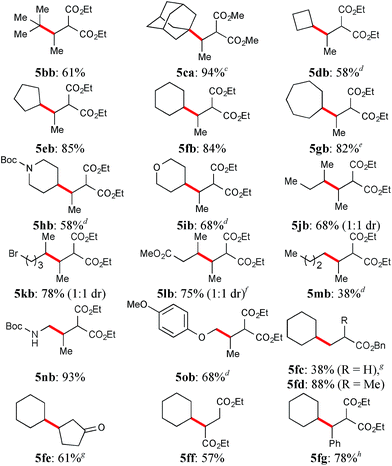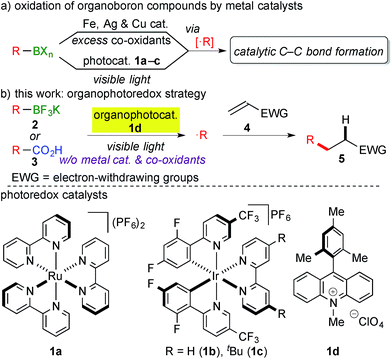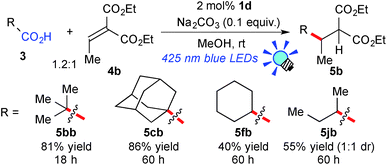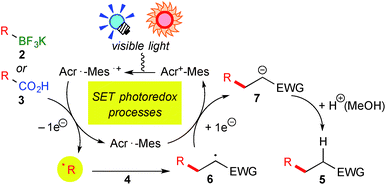Redox-economical radical generation from organoborates and carboxylic acids by organic photoredox catalysis†
Tatsuya Chinzei,
Kazuki Miyazawa,
Yusuke Yasu,
Takashi Koike* and
Munetaka Akita*
Chemical Resources Laboratory, Tokyo Institute of Technology, 4259 Nagatsuta, Midori-ku, Yokohama 226-8503, Japan. E-mail: koike.t.ad@m.titech.ac.jp; makita@res.titech.ac.jp; Fax: +81-45-924-5230; Tel: +81-45-924-5230
First published on 13th February 2015
Abstract
A simple generation method of carbon radicals via 1e-oxidation of organotrifluoroborates and carboxylic acids by the action of an organophotoredox catalyst, 9-mesityl-10-methylacridinium perchlorate ([Acr+–Mes]ClO4), has been developed. This organophotocatalytic protocol is amenable to radical C–C bond formation with electron-deficient olefins.
Over the past few years, photoredox catalysis, which is composed of visible-light-induced single-electron-transfer (SET) processes, has become a powerful tool in the field of synthetic organic chemistry.1 In particular, a well-defined tris(2,2′-bipyridine) ruthenium(II) complex (1a) and the relevant cyclometalated iridium(III) derivatives (1b and 1c) have been proven to be useful transition metal photocatalysts for invaluable radical transformations. On the other hand, organic photoredox catalysis has also been attracting great interest in terms of the elements strategy initiative and green chemistry.2
Organoboronic acid derivatives and organoborates are regarded as convenient radical precursors in terms of high stability, low toxicity and high compatibility with various functional groups. One-electron oxidation of organoboron compounds smoothly generates reactive carbon-centered radicals through deboronation. Recently, some metal-catalyzed radical reactions using organoboronic acid derivatives have been reported, but they usually require an excess amount of co-oxidants (the upper process in Scheme 1a).3 More recently, our group and the groups of Chen and Molander have developed radical reactions of organoborates designed by Ru or Ir photoredox catalysis (the lower process in Scheme 1a).4,5
In this communication, we describe a simple generation method of carbon-centered radicals from organotrifluoroborates 2 and carboxylic acids 3 by the action of 9-mesityl-10-methylacridinium perchlorate ([Acr+–Mes]ClO4 (1d)), an organophotoredox catalyst developed by Fukuzumi and Ohkubo.6,7 The photoinduced electron-transfer state of 1d is known as an oxidant (+1.65 V vs. Cp2Fe) which is stronger than those of the Ru and Ir photoredox catalysts. Thus, 1d enables oxidative transformation, which cannot be promoted by metal photoredox catalysis. We will describe a new and simple protocol for the generation of organic radicals from organoborates 2 and carboxylic acids 3, which is followed by radical C–C bond formation without noble metals and co-oxidants (Scheme 1b).
We initially examined the photocatalytic reaction of potassium phenethyltrifluoroborate (2a) with ethylidenemalonic acid dimethyl ester (4a) in the presence of 1d (2 mol%) in a 1![[thin space (1/6-em)]](https://www.rsc.org/images/entities/char_2009.gif) :
:![[thin space (1/6-em)]](https://www.rsc.org/images/entities/char_2009.gif) 1 acetone-d6 and CD3OD mixture under visible light irradiation (blue LEDs: λmax = 425 nm) for 24 h (entry 1 in Table 1). As a result, the addition product 5aa was obtained in a 64% NMR yield (24 h). An elongated reaction time (48 h) gave a better yield (79%). The acetone–methanol mixed solvent system resulted in the highest yield (entries 1–5). It should be noted that the typical transition metal photoredox catalysts (1a–c) afforded the product in considerably lower yields (entries 6–8). The reactivity of the organocatalyst 1d was superior to that of metal catalysts 1a–c and can be ascribed to the oxidation potentials of the photoactivated species (1a: +0.43 V, 1b: +0.91 V, 1c: +0.80 V, 1d: +1.65 V vs. Cp2Fe).1d,f The organoborate 2a (oxidation potential: +1.41 V vs. Cp2Fe) is readily oxidized by the photoactivated 1d but not by the excited 1a–c. Both the photocatalyst and visible light were essential for the present reaction (entries 9 and 10), strongly supporting the hypothesis that the photoactivated species of the photocatalyst is involved in the reaction.
1 acetone-d6 and CD3OD mixture under visible light irradiation (blue LEDs: λmax = 425 nm) for 24 h (entry 1 in Table 1). As a result, the addition product 5aa was obtained in a 64% NMR yield (24 h). An elongated reaction time (48 h) gave a better yield (79%). The acetone–methanol mixed solvent system resulted in the highest yield (entries 1–5). It should be noted that the typical transition metal photoredox catalysts (1a–c) afforded the product in considerably lower yields (entries 6–8). The reactivity of the organocatalyst 1d was superior to that of metal catalysts 1a–c and can be ascribed to the oxidation potentials of the photoactivated species (1a: +0.43 V, 1b: +0.91 V, 1c: +0.80 V, 1d: +1.65 V vs. Cp2Fe).1d,f The organoborate 2a (oxidation potential: +1.41 V vs. Cp2Fe) is readily oxidized by the photoactivated 1d but not by the excited 1a–c. Both the photocatalyst and visible light were essential for the present reaction (entries 9 and 10), strongly supporting the hypothesis that the photoactivated species of the photocatalyst is involved in the reaction.
| Entry | Photocatalyst | Solvent | NMR yield of 5aa/% |
|---|---|---|---|
| a Reaction conditions: a reaction mixture of 2a (0.06 mmol), 4a (0.05 mmol), photocatalyst (1.0 μmol), SiEt4 (an internal standard) and solvent (0.50 mL) was irradiated by 3 W blue LEDs (λ = 425 ± 15 nm) at room temperature for 24 h.b Reaction time = 48 h.c The reaction was conducted in the dark. | |||
| 1 | 1d | Acetone-d6/CD3OD (1/1) | 64, 79b |
| 2 | 1d | Acetone-d6 | 28 |
| 3 | 1d | CD3OD | 34 |
| 4 | 1d | CD3CN | 53 |
| 5 | 1d | DMSO-d6 | 0 |
| 6 | 1a | Acetone-d6/CD3OD (1/1) | 0 |
| 7 | 1b | Acetone-d6/CD3OD (1/1) | 13 |
| 8 | 1c | Acetone-d6/CD3OD (1/1) | 3 |
| 9c | 1d | Acetone-d6/CD3OD (1/1) | 0 |
| 10 | None | Acetone-d6/CD3OD (1/1) | 0 |
Next, we examined the scope of the present photocatalytic reaction (Table 2). The reaction of tertiary-alkyltrifluoroborates (2b and 2c) smoothly proceeded with the construction of a quaternary carbon center to give the corresponding products (5bb and 5ca) in 61% and 94% yields, respectively. Secondary-alkyltrifluoroborates (2d–l), regardless of cyclic or acyclic structures, afforded the products (5db–lb) in good yields (58–85%). Primary-alkyltrifluoroborates (2m–o) were also applied to this photocatalytic system (38–93% yields). It is noteworthy that the addition of more substituted alkyl groups is rather efficient in the present C–C bond formation. Tolerance to a variety of functionalities such as Br (2k), ester (2l), Boc-protected amines (2h and 2n) and ethers (2i and 2o) is particularly significant. Furthermore, the reaction of potassium cyclohexyltrifluoroborate (2f) with a range of electron-deficient alkenes, acrylate derivatives (4c and 4d) and alkenes bearing a substituent at the reaction site (4e, 4f and 4g), provided the corresponding C–C coupled products (5fc–5fg: 38–88%). These results reveal that the present photocatalytic system enables the selective generation of various alkyl radicals with/without functionalities from the corresponding organoborates.
| a Reaction conditions: a reaction mixture of 2 (0.36 mmol), 4 (0.30 mmol), 1d (6.1 μmol), acetone (1.5 mL) and MeOH (1.5 mL) was irradiated by 3 W blue LEDs (λ = 425 ± 15 nm) at room temperature for 24 h.b Isolated yields.c Reaction time = 12 h.d Reaction time = 36 h.e Reaction time = 18 h.f Reaction time = 60 h.g Reaction time = 15 h.h Reaction time = 48 h. |
|---|
 |
Remarkably, sunlight, which includes visible light as the main component, can be utilized as the light source. To our surprise, the sunlight-driven system was more efficient than the blue LED system. The reaction of 2f with 4b was completed within 18 h under daylight (eqn (1)).
 | (1) |
Encouraged by these results, we next investigated the generation of organic radicals from carboxylic acids by the present organophotoredox system. Carboxylic acids are readily available and known to serve as C-radical sources through 1e-oxidation followed by decarboxylation.8 We optimized the reaction of pivalic acid (3b) with 4b (see the ESI†). To our delight, the reaction of 3b with 4b in the presence of Na2CO3 (0.1 equiv.) and organophotocatalyst 1d (2 mol%) proceeded smoothly to give the corresponding product 5bb in an 81% isolated yield (Scheme 2). However, the efficiency of the reactions of 1-adamantanecarboxylic acid (3c), cyclohexanecarboxylic acid (3f) and 2-methylbutyric acid (3j) declined (60 h).9 In addition, the reactions of 3-phenylpropionic acid (3a) and n-pentanoic acid (3m) did not proceed at all. These results show that this organophotoredox catalysis can be applied to the oxidation of carboxylic acids, but the scope of the reaction is rather limited compared to the reaction of organoborates.
On the basis of our study and previous reports,4,6,7 a plausible reaction scheme through a redox-neutral process is illustrated in Scheme 3. First, visible light irradiation (blue LEDs or sunlight) causes excitation of the organocatalyst 1d into a photoinduced electron-transfer state, Acr˙–Mes˙+, which serves as a strong oxidant, through the excited state, *[Acr+–Mes]. A carbon-centered radical is generated via the 1e-oxidation of organoborate 2 or carboxylic acid 3 by Acr˙–Mes˙+ accompanying the formation of the reduced species, Acr˙–Mes. The organic radical reacts with an electron-deficient alkene 4 to give the radical intermediate 6, subsequent 1e-reduction of which by Acr˙–Mes provides a carboanion intermediate 7. Finally, smooth protonation by the solvent, MeOH, produces the adduct 5. Control experiments in CD3OH revealed that the α-H atom in the product 5 does not result from hydrogen abstraction from the CD3 group but from protonation with the OH group (see the ESI†), supporting the involvement of a carboanionic intermediate 7.
In conclusion, we have developed a novel redox-economical photocatalytic radical reaction via oxidative generation of carbon radicals from organotrifluoroborates and carboxylic acids by the action of an organophotoredox catalyst, [Acr+–Mes]ClO4. The present organocatalytic strategy turns out to be free of a noble metal catalyst, co-oxidant and toxic/explosive chemicals. In particular, owing to the high oxidation potential of photoinduced electron-transfer state, [Acr+–Mes]ClO4 can generate organic radicals from a variety of organoborates, which cannot be smoothly mediated by the Ru and Ir species. Further development of the synthetically valuable organic photoredox catalysis and redox-economical reaction is a continuing effort in our laboratory.
Acknowledgements
The financial support from the Japanese government (Grant-in-Aid for Scientific Research: no. 26288045) is gratefully acknowledged.Notes and references
- For selected reviews on photoredox catalysis using Ru and Ir complexes, see: (a) T. P. Yoon, M. A. Ischay and J. Du, Nat. Chem., 2010, 2, 527 CrossRef CAS PubMed; (b) J. M. R. Narayanam and C. R. J. Stephenson, Chem. Soc. Rev., 2011, 40, 102 RSC; (c) J. Xuan and W.-J. Xiao, Angew. Chem., Int. Ed., 2012, 51, 6828 CrossRef CAS PubMed; (d) C. K. Prier, D. A. Rankic and D. W. C. MacMillan, Chem. Rev., 2013, 113, 5322 CrossRef CAS PubMed; (e) M. Reckenthäler and A. G. Griesbeck, Adv. Synth. Catal., 2013, 355, 2727 CrossRef; (f) T. Koike and M. Akita, Inorg. Chem. Front., 2014, 1, 562 RSC; (g) T. Koike and M. Akita, Top. Catal., 2014, 57, 967 CrossRef CAS PubMed; (h) D. M. Schultz and T. P. Yoon, Science, 2014, 343, 1239176 CrossRef PubMed.
- For recent reviews on organic photoredox catalysis, see: (a) D. Ravelli and M. Fagnoni, ChemCatChem, 2012, 4, 169 CrossRef CAS; (b) M. L. Marin, L. Santos-Juanes, A. Arques, A. M. Amat and M. A. Miranda, Chem. Rev., 2012, 112, 1710 CrossRef CAS PubMed; (c) D. Ravelli, M. Fagnoni and A. Albini, Chem. Soc. Rev., 2013, 42, 97 RSC; (d) S. Fukuzumi and K. Ohkubo, Chem. Sci., 2013, 4, 561 RSC; (e) D. A. Nicewicz and T. M. Nguyen, ACS Catal., 2014, 4, 355 CrossRef CAS; (f) D. P. Hari and B. König, Chem. Commun., 2014, 50, 6688 RSC; (g) S. Fukuzumi and K. Ohkubo, Org. Biomol. Chem., 2014, 12, 6059 RSC.
- (a) I. B. Seiple, S. Su, R. A. Rodriguez, R. Gianatassio, Y. Fujiwara, A. L. Sobel and P. S. Baran, J. Am. Chem. Soc., 2010, 132, 13194 CrossRef CAS PubMed; (b) Y. Fujiwara, V. Domingo, I. B. Seiple, R. Gianatassio, M. D. Bel and P. S. Baran, J. Am. Chem. Soc., 2011, 133, 3292 CrossRef CAS PubMed; (c) N. Uchiyama, E. Shirakawa, R. Nishikawa and T. Hayashi, Chem. Commun., 2011, 47, 11671 RSC; (d) T. W. Liwosz and S. R. Chemler, Org. Lett., 2013, 15, 3034 CrossRef CAS PubMed; (e) A. Deb, S. Manna, A. Maji, U. Dutta and D. Maiti, Eur. J. Org. Chem., 2013, 5251 CrossRef CAS; (f) K. Komeyama, T. Kashihara and K. Takaki, Tetrahedron Lett., 2013, 54, 1084 CrossRef CAS PubMed; (g) A. Deb, S. Agasti, T. Saboo and D. Maiti, Adv. Synth. Catal., 2014, 356, 705–710 CrossRef CAS.
- (a) Y. Yasu, T. Koike and M. Akita, Adv. Synth. Catal., 2012, 354, 3414 CrossRef CAS; (b) K. Miyazawa, Y. Yasu, T. Koike and M. Akita, Chem. Commun., 2013, 49, 7249 RSC; (c) T. Koike and M. Akita, Synlett, 2013, 24, 2492 CrossRef CAS PubMed; (d) K. Miyazawa, T. Koike and M. Akita, Adv. Synth. Catal., 2014, 356, 2749 CrossRef CAS.
- (a) H. Huang, G. Zhang, L. Gong, S. Zhang and Y. Chen, J. Am. Chem. Soc., 2014, 136, 2280 CrossRef CAS PubMed; (b) J. C. Tellis, D. N. Primer and G. A. Molandar, Science, 2014, 345, 443 CrossRef PubMed.
- (a) S. Fukuzumi, H. Kotani, K. Ohkubo, S. Ogo, N. V. Tkachenko and H. Lemmetyinen, J. Am. Chem. Soc., 2004, 126, 1600 CrossRef CAS PubMed; (b) K. Ohkubo, K. Mizushima, R. Iwata, K. Souma, N. Suzuki and S. Fukuzumi, Chem. Commun., 2010, 46, 601 RSC; (c) K. Ohkubo, K. Mizushima, R. Iwata and S. Fukuzumi, Chem. Sci., 2011, 2, 715 RSC; (d) M. Hoshino, H. Uekusa, A. Tomita, S. Koshihara, T. Sato, S. Nozawa, S. Adachi, K. Ohkubo, H. Kotani and S. Fukuzumi, J. Am. Chem. Soc., 2012, 134, 4569 CrossRef CAS PubMed.
- For selected reports on photoredox catalysis using 1d, see: (a) D. S. Hamilton and D. A. Nicewicz, J. Am. Chem. Soc., 2012, 134, 18577 CrossRef CAS PubMed; (b) D. J. Wilger, N. J. Gesmundo and D. A. Nicewicz, Chem. Sci., 2013, 4, 3160 RSC; (c) T. M. Nguyen and D. A. Nicewicz, J. Am. Chem. Soc., 2013, 135, 9588 CrossRef CAS PubMed; (d) J.-M. M. Grandjean and D. A. Nicewicz, Angew. Chem., Int. Ed., 2013, 52, 3967 CrossRef CAS PubMed; (e) J. Xuan, X.-D. Xia, T.-T. Zeng, Z.-J. Feng, J.-R. Chen, L.-Q. Lu and W.-J. Xiao, Angew. Chem., Int. Ed., 2014, 53, 5653 CrossRef CAS PubMed; (f) T. M. Nguyen, N. Manohar and D. A. Nicewicz, Angew. Chem., Int. Ed., 2014, 53, 6198 CrossRef CAS PubMed.
- During preparation of the present manuscript, related works on decarboxylative generation of C-radicals by photoredox catalysis were reported, see: (a) J. Liu, Q. Liu, H. Yi, C. Qin, R. Bai, X. Qi, Y. Lan and A. Lei, Angew. Chem., Int. Ed., 2014, 53, 502 CrossRef CAS PubMed; (b) Z. Zuo and D. W. C. MacMillan, J. Am. Chem. Soc., 2014, 136, 5257 CrossRef CAS PubMed; (c) Z. Zuo, D. T. Ahneman, L. Chu, J. A. Terrett, A. G. Doyle and D. W. C. MacMillan, Science, 2014, 345, 437 CrossRef CAS PubMed; (d) L. Chu, C. Ohta, Z. Zuo and D. W. C. MacMillan, J. Am. Chem. Soc., 2014, 136, 10886 CrossRef CAS PubMed; (e) A. Noble and D. W. C. MacMillan, J. Am. Chem. Soc., 2014, 136, 11602 CrossRef CAS PubMed; (f) C. Cassani, G. Bergonzini and C.-J. Wallentin, Org. Lett., 2014, 16, 4228 CrossRef CAS PubMed.
- The reactions of 3f and 3j were not completed under these conditions.
Footnote |
| † Electronic supplementary information (ESI) available: Experimental details and spectral data. See DOI: 10.1039/c5ra01826a |
| This journal is © The Royal Society of Chemistry 2015 |





